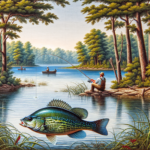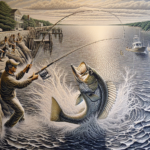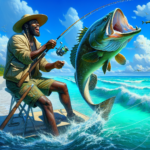Shark Fishing in Texas’ Gulf Coast

Introduction
Did you know that the Gulf Coast of Texas is home to some of the most diverse and abundant shark populations in the United States? Whether you’re an experienced angler or a novice looking to try your hand at shark fishing, the Texas Gulf Coast offers a unique and thrilling experience. This article will delve into the various aspects of shark fishing in this region, including the best techniques, species information, top fishing spots, and essential gear. We’ll also cover important regulations, seasonal considerations, and safety tips to ensure a successful and responsible fishing trip.
Background/Context
Historical or Cultural Significance
Shark fishing has a long history along the Texas Gulf Coast, dating back to indigenous tribes who relied on the ocean’s bounty for sustenance. In more recent times, shark fishing has become a popular recreational activity, drawing anglers from all over the country. The cultural significance of shark fishing in Texas is also evident in local festivals and tournaments that celebrate this thrilling sport.
Geographical Overview
The Texas Gulf Coast stretches over 350 miles from the Louisiana border to the Rio Grande. This region is characterized by its warm climate, sandy beaches, and diverse marine ecosystems. The Gulf of Mexico’s warm waters provide an ideal habitat for various shark species, making it a prime location for shark fishing. The coastal areas are also home to estuaries, bays, and offshore reefs, which contribute to the rich biodiversity of the region.
Key Points/Details
Fishing Techniques
Technique Overview
Shark fishing techniques can vary depending on the species targeted and the fishing location. Common methods include surf fishing, boat fishing, and using specialized rigs like the “shark rig” or “drum rig.” Chumming, or using bait to attract sharks, is also a popular technique.
When and Where to Use
Surf fishing is ideal for anglers who prefer to fish from the shore, particularly in areas with deep drop-offs close to the beach. Boat fishing allows access to deeper waters and offshore reefs where larger sharks are often found. Chumming is most effective in areas with strong currents that can disperse the scent of the bait over a wide area.
Recommended Gear
- Rods: Heavy-duty surf rods or boat rods, typically 6-10 feet in length.
- Reels: High-capacity spinning or conventional reels with strong drag systems.
- Lines: Braided lines with a minimum of 50-80 lb test strength.
- Bait: Fresh or frozen fish, squid, or cut bait.
- Rigs: Shark rigs with wire leaders and circle hooks to prevent bite-offs.
Species Information
Species Overview
The Texas Gulf Coast is home to several shark species, including Blacktip Sharks, Bull Sharks, Hammerhead Sharks, and Tiger Sharks. Each species has unique habits and preferred habitats.
Best Practices
To successfully catch sharks, it’s essential to understand their behavior and habitat preferences. Blacktip Sharks are often found in shallow waters near the shore, while Bull Sharks prefer estuaries and river mouths. Hammerhead and Tiger Sharks are typically found in deeper offshore waters. Using fresh bait and chumming can increase your chances of attracting these predators.
Location Information
Top Fishing Spots
- Galveston Island: Known for its accessible beaches and piers, Galveston is a popular spot for surf fishing and boat charters.
- Port Aransas: Offers excellent opportunities for both inshore and offshore shark fishing, with numerous charter services available.
- South Padre Island: Renowned for its clear waters and abundant marine life, making it a prime location for shark fishing.
Regulations and Licenses
Anglers must adhere to Texas Parks and Wildlife Department (TPWD) regulations, which include obtaining a valid fishing license and following specific catch limits and size restrictions for different shark species. It’s crucial to stay updated on current regulations to ensure responsible and legal fishing practices.
Seasonal Considerations
Seasonal Variations
Shark fishing conditions can vary throughout the year. Summer months typically offer the best opportunities, as warmer waters attract more sharks closer to shore. However, some species, like Bull Sharks, can be found year-round.
Best Times to Fish
The optimal times for shark fishing are during early morning and late evening when sharks are most active. Tidal changes and moon phases can also influence shark activity, so it’s beneficial to plan your trip around these factors.
Events and Tournaments
Event Overview
The Texas Gulf Coast hosts several shark fishing tournaments, such as the Texas Shark Rodeo and the Sharkathon. These events offer anglers the chance to compete for prizes and recognition while promoting conservation and sustainable fishing practices.
Preparation Tips
To prepare for a tournament, ensure your gear is in top condition, practice your casting and reeling techniques, and familiarize yourself with the tournament rules and regulations. Pre-fishing the area can also give you an advantage by identifying potential hotspots.
Tips and Best Practices
General Tips
- Always use fresh bait to increase your chances of attracting sharks.
- Be patient and prepared for a long fight, as sharks are powerful and resilient.
- Practice catch and release to promote conservation and ensure the sustainability of shark populations.
Avoid Common Mistakes
- Using inadequate gear: Ensure your rod, reel, and line are strong enough to handle large sharks.
- Ignoring regulations: Always stay updated on local fishing regulations to avoid fines and promote responsible fishing.
- Improper handling: Use proper techniques to handle and release sharks safely to minimize harm to the fish and yourself.
Advanced Techniques
- Using live bait: Live bait can be more effective in attracting sharks, but requires additional skills and equipment to keep the bait alive.
- Drifting: Drifting with the current can cover more area and increase your chances of encountering sharks.
- Night fishing: Sharks are more active at night, making it an ideal time for experienced anglers to target them.
Gear and Equipment Recommendations
Essential Gear
- Heavy-duty surf or boat rods
- High-capacity spinning or conventional reels
- Braided lines with 50-80 lb test strength
- Shark rigs with wire leaders and circle hooks
- Fresh or frozen bait
Optional Gear/Upgrades
- Live bait tanks
- Chum buckets
- Fishing kayaks for inshore fishing
- GPS and fish finders for offshore fishing
Where to Buy or Rent
Local bait and tackle shops in coastal towns like Galveston, Port Aransas, and South Padre Island offer a wide range of fishing gear and equipment. Online retailers like Bass Pro Shops and Cabela’s also provide extensive selections for shark fishing enthusiasts.
Safety and Conservation
Safety Tips
- Always fish with a buddy and inform someone of your fishing plans.
- Wear appropriate safety gear, including life jackets when fishing from a boat.
- Be cautious of weather conditions and avoid fishing during storms or rough seas.
- Handle sharks with care to avoid injury from their teeth and thrashing movements.
Conservation Practices
- Practice catch and release to help maintain healthy shark populations.
- Use circle hooks to reduce injury to sharks and increase survival rates upon release.
- Follow local regulations and size limits to ensure sustainable fishing practices.
- Participate in conservation programs and report any tagged sharks you catch to contribute to research efforts.
Planning Your Trip
Accommodations
Coastal towns like Galveston, Port Aransas, and South Padre Island offer a variety of accommodations, ranging from beachfront hotels and resorts to budget-friendly motels and vacation rentals. Booking in advance is recommended, especially during peak fishing seasons and local events.
Travel Tips
Most coastal towns are accessible by car, with major highways connecting them to larger cities like Houston and Corpus Christi. If flying, the closest airports are Houston’s George Bush Intercontinental Airport (IAH) and Corpus Christi International Airport (CRP). Renting a car is advisable for easy access to fishing spots and local amenities.
Additional Activities
In addition to shark fishing, the Texas Gulf Coast offers a range of activities for non-fishing time, including beachcombing, birdwatching, kayaking, and exploring local attractions like the Texas State Aquarium in Corpus Christi and the historic Strand District in Galveston.
Frequently Asked Questions (FAQs)
Do I need a special license to fish for sharks in Texas?
Yes, you need a valid Texas fishing license, and you must adhere to specific regulations regarding shark species, size limits, and catch limits. Check the Texas Parks and Wildlife Department website for the most current information.
What is the best time of year for shark fishing on the Texas Gulf Coast?
Summer months are generally the best time for shark fishing, as warmer waters attract more sharks closer to shore. However, some species can be found year-round.
Can I keep the sharks I catch?
While some shark species can be kept, many are protected, and there are strict regulations regarding size and catch limits. It’s essential to stay updated on current regulations and practice catch and release whenever possible.
What should I do if I catch a tagged shark?
If you catch a tagged shark, record the tag number, location, and any other relevant information, and report it to the appropriate conservation organization or research program. This data helps researchers track shark movements and populations.
Conclusion
Shark fishing on the Texas Gulf Coast offers an exciting and rewarding experience for anglers of all skill levels. By understanding the best techniques, species information, top fishing spots, and essential gear, you can increase your chances of a successful trip. Remember to follow local regulations, practice conservation, and prioritize safety to ensure a responsible and enjoyable fishing adventure. Whether you’re targeting Blacktip Sharks in shallow waters or venturing offshore for Hammerheads, the Texas Gulf Coast provides a unique opportunity to connect with nature and experience the thrill of shark fishing.




